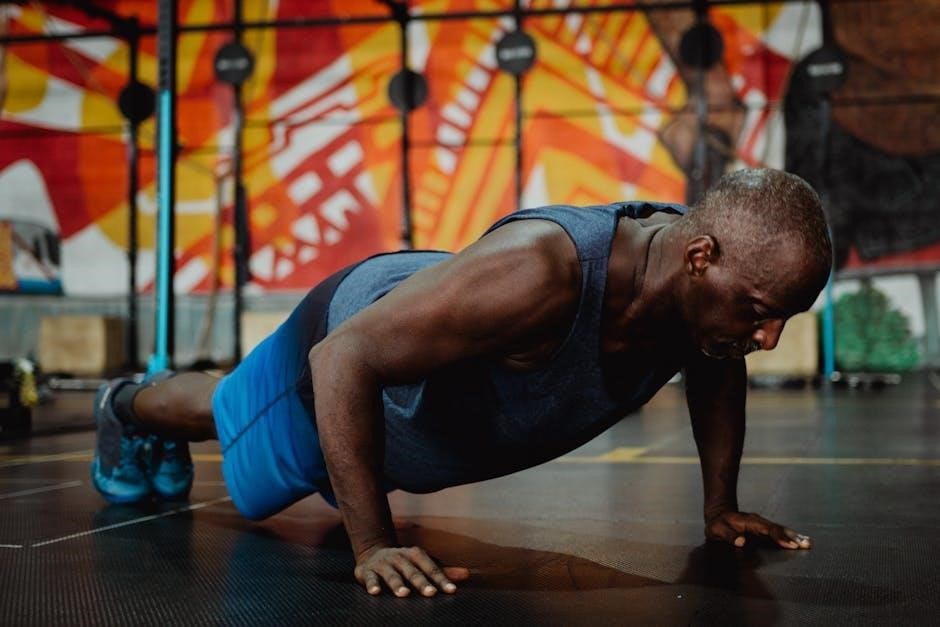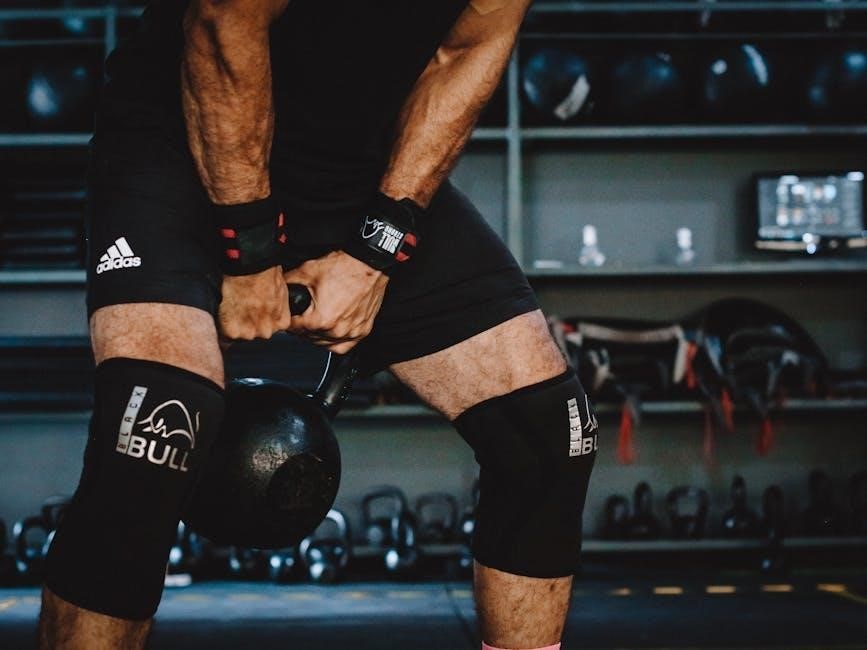
HIIT (High-Intensity Interval Training) workouts combine short bursts of intense exercise with brief rest periods, offering a time-efficient way to burn calories and improve cardiovascular health.
What is HIIT?
HIIT, or High-Intensity Interval Training, involves short bursts of intense exercise followed by brief periods of rest or low-intensity activity. This training method is designed to maximize calorie burn and improve cardiovascular health in a short amount of time. Unlike traditional workouts, HIIT alternates between high-energy efforts and recovery phases, making it highly efficient. Workouts typically last 10 to 30 minutes, appealing to those with busy schedules. HIIT can be performed with or without equipment, focusing on bodyweight exercises, dumbbells, or other tools. Its versatility allows for customization to suit different fitness levels and goals. The intense intervals push the body to its limits, promoting significant metabolic changes and fat burning even after the workout ends. This format has made HIIT a popular choice for achieving quick, noticeable results.
Benefits of HIIT Workouts
HIIT workouts offer numerous benefits, making them a highly effective training method. They are known for their time efficiency, delivering significant results in shorter sessions compared to traditional exercises. One of the primary advantages is the substantial calorie burn during and after the workout, thanks to the “afterburn effect,” where the body continues to burn calories post-exercise. HIIT also enhances cardiovascular health by improving heart rate and increasing oxygen consumption. Additionally, it promotes muscle strength and endurance, as the intense bursts of activity challenge multiple muscle groups. Another benefit is the improvement in metabolic function, which aids in weight loss and overall physical fitness. The versatility of HIIT allows it to be adapted to various fitness levels, making it accessible to both beginners and advanced individuals. Overall, HIIT provides a well-rounded workout that boosts physical performance and supports long-term health goals.

Why HIIT is Popular
HIIT, or High-Intensity Interval Training, has gained immense popularity due to its effectiveness and convenience. One key reason is its time efficiency—workouts are typically short, lasting 20-30 minutes, making it ideal for those with busy schedules. The significant calorie burn and the “afterburn effect,” where the body continues to burn calories post-workout, are major attractions. Additionally, HIIT can be done anywhere without specialized equipment, appealing to a wide audience. It improves cardiovascular health, increases endurance, and can be adapted to various fitness levels. The variety of exercises keeps routines engaging, and the sense of community in group classes motivates participants. Scientific backing showcasing its benefits, such as improved insulin sensitivity and metabolism, further boosts its appeal. Overall, HIIT’s blend of efficiency, adaptability, and proven results makes it a preferred choice for many.

Understanding HIIT Training
HIIT involves short bursts of intense exercise followed by brief recovery periods, designed to maximize calorie burn and improve fitness in minimal time.
Structure of a HIIT Workout
A typical HIIT workout consists of a warm-up, followed by alternating periods of high-intensity exercises and short rest periods. These cycles, often lasting 15–30 seconds each, are repeated for 15–20 minutes. The workout concludes with a cool-down. The structure is designed to push the body to its limits during work periods while allowing brief recovery phases. For example, a session might include 30 seconds of sprints followed by 30 seconds of rest, repeated 8–12 times. Some plans incorporate strength training or core exercises within the intervals. The variability in routines allows customization based on fitness levels and goals. Proper timing and intensity are key to maximizing results while minimizing injury risks. HIIT’s structured yet flexible format makes it adaptable for both beginners and advanced athletes.

Key Components of HIIT
HIIT workouts are built around short, intense bursts of effort followed by brief recovery periods. The core components include timed intervals, maximum effort during work periods, and active or passive rest phases. The workouts typically involve bodyweight exercises, plyometrics, or resistance training, ensuring full-body engagement. Functional movements like burpees, sprints, and jump squats are common. Scalability is another key feature, allowing workouts to be adapted to different fitness levels. The structured timing and balance between intensity and recovery prevent overtraining while maximizing results. These components ensure efficient calorie burn, improved cardiovascular fitness, and enhanced muscular endurance. Consistency and proper execution of these elements are essential for achieving desired outcomes and maintaining long-term progress.
Duration and Intensity

HIIT workouts are designed to be short but highly intense, typically lasting between 15 to 45 minutes. The duration is balanced with maximum effort during work periods, usually ranging from 20 to 60 seconds, followed by rest or low-intensity recovery phases of 15 to 60 seconds. The intensity is a critical component, requiring participants to push themselves to 80-100% of their maximum heart rate during active intervals. This high-intensity approach ensures efficient calorie burning and cardiovascular improvement. The structured time frame allows for a full-body workout in minimal time, making HIIT appealing for those with busy schedules. The combination of short bursts and strategic rest periods maximizes results while preventing overtraining, ensuring a safe and effective workout experience for all fitness levels.
Benefits of HIIT Workouts
HIIT workouts offer numerous benefits, including improved cardiovascular health, enhanced endurance, and increased metabolism, making them an excellent choice for achieving fitness goals efficiently.
Calorie Burning and Weight Loss
HIIT workouts are highly effective for calorie burning and weight loss due to their intense nature and short rest periods. These sessions push your body to its limits, maximizing caloric expenditure during and after exercise. The “afterburn effect,” or excess post-exercise oxygen consumption (EPOC), means your metabolism stays elevated for up to 24 hours post-workout, burning additional calories. This makes HIIT a time-efficient way to shed pounds and improve overall fitness. By incorporating HIIT into your routine, you can achieve significant weight loss while toning your body. Many HIIT training PDF guides provide structured workouts that focus on calorie-torching exercises, making it easier to stay consistent and see results.
Muscle Building and Strength
HIIT workouts are not only for cardio but also excel at building muscle and strength. By incorporating strength-based exercises like squats, push-ups, and lunges into high-intensity intervals, HIIT engages multiple muscle groups simultaneously. This promotes muscle hypertrophy and enhances overall strength. The short, intense bursts of effort in HIIT stimulate muscle fibers, leading to increased muscle mass over time. Additionally, the full-body nature of HIIT workouts ensures a balanced approach to strength training, targeting both upper and lower body muscles. Many HIIT training PDF guides include routines specifically designed to focus on strength gains, making it an effective option for those looking to build lean muscle while improving cardiovascular fitness. This dual benefit makes HIIT a versatile choice for fitness enthusiasts.
Cardiovascular Health
HIIT workouts significantly improve cardiovascular health by enhancing the body’s ability to deliver and utilize oxygen. The high-intensity bursts increase heart rate and strengthen the heart muscle, leading to better circulation and overall cardiac function. Regular HIIT sessions can lower blood pressure, improve lung capacity, and boost the efficiency of oxygen delivery to cells. Unlike steady-state cardio, HIIT pushes the heart to its maximum capacity, promoting faster adaptations in cardiovascular fitness. This makes HIIT an excellent choice for improving endurance, reducing the risk of heart disease, and enhancing overall cardiovascular well-being. Many HIIT training PDF guides include cardio-focused routines that target these benefits, making them a valuable resource for improving heart health.

Time Efficiency
HIIT workouts are renowned for their time efficiency, making them ideal for individuals with busy schedules. These short, intense sessions typically last 15-30 minutes, delivering impressive results in less time than traditional workouts. The structured format of HIIT training workouts PDFs ensures that every minute is optimized for maximum calorie burn and physical improvement. By focusing on short bursts of high-intensity effort followed by brief rest periods, HIIT maximizes efficiency, allowing users to achieve significant fitness gains without spending hours at the gym. This time-saving aspect is a major reason why HIIT has become a favorite among fitness enthusiasts. Many HIIT training PDF guides offer quick, effective routines that can be completed anywhere, making it easier to maintain a consistent workout routine even on the busiest days.
Sample HIIT Workouts from PDF Guides
Explore a variety of HIIT workouts from PDF guides, featuring bodyweight exercises, dumbbell routines, and full-body circuits designed for all fitness levels. These structured routines are easy to follow and require minimal equipment.
Bodyweight Exercises
Bodyweight exercises are a cornerstone of HIIT workouts, offering simplicity and effectiveness without equipment. Popular moves like push-ups, squats, lunges, planks, and mountain climbers target multiple muscle groups. These exercises are ideal for HIIT because they can be performed in intervals, such as 30 seconds of intense effort followed by 30 seconds of rest. Many HIIT PDF guides include bodyweight circuits that combine these exercises for a full-body workout. The versatility of bodyweight exercises allows for modifications to suit different fitness levels, making them accessible to beginners and challenging for advanced individuals. Incorporating these exercises into your HIIT routine can improve cardiovascular health, increase strength, and boost endurance. They’re also convenient for home workouts, requiring minimal space and no equipment. HIIT training PDFs often feature bodyweight routines that are easy to follow and highly effective for achieving fitness goals.
Dumbbell HIIT Routines
Dumbbell HIIT routines are versatile and effective for building strength and endurance. These workouts often combine dynamic movements like goblet squats, dumbbell snatches, and renegade rows. HIIT training PDFs frequently include dumbbell exercises due to their portability and ability to target multiple muscle groups. A typical routine might involve 40 seconds of work followed by 20 seconds of rest, repeated for 15-20 minutes. Dumbbells allow for progressive overload, making them suitable for all fitness levels. They also enhance coordination and balance. Many PDF guides provide dumbbell-specific circuits that can be done at home or in a gym. Dumbbell HIIT routines are ideal for those who prefer compact, efficient workouts without sacrificing intensity or results. They’re a great way to incorporate resistance training into a high-intensity interval format, maximizing calorie burn and muscle engagement.
Full-Body Circuit Training
Full-body circuit training is a cornerstone of HIIT workouts, designed to engage all major muscle groups in a single session. These circuits typically involve 8-12 exercises performed in rapid succession, with minimal rest between sets. Movements like burpees, jump squats, push-ups, and mountain climbers are common. HIIT training PDFs often feature circuits that target cardiovascular endurance, strength, and agility simultaneously. A full-body circuit usually lasts 30-45 minutes, making it a time-efficient option for comprehensive fitness. The variety of exercises prevents plateaus and keeps workouts engaging. Many PDF guides include modifications for different fitness levels, ensuring accessibility. Full-body circuits are ideal for those seeking a balanced, intense workout that improves overall athleticism and burns calories effectively. They’re a key component of HIIT routines, offering a holistic approach to fitness in a structured format.

Resources for HIIT Training PDFs
Discover reputable sources offering HIIT training PDFs, including fitness websites, health blogs, and platforms like Google Drive or Dropbox, providing structured workout guides for free or purchase.
Where to Find Free HIIT Workout Plans
Finding free HIIT workout plans is easy with numerous online resources. Websites like Fitness Blender and HIIT It Off offer downloadable PDF guides tailored for various fitness levels. Social media platforms, such as Facebook groups and Reddit forums, often share free HIIT routines. Additionally, platforms like Google Drive and Dropbox host a variety of free workout plans shared by fitness enthusiasts and trainers. Many blogs and health websites also provide free PDFs with structured HIIT workouts, including warm-ups, exercises, and cool-down stretches. Mobile apps like Nike Training Club and JEFIT offer free HIIT plans that you can download or print. These resources are perfect for those looking to start HIIT without spending money.

Recommended PDF Guides
Several top-rated HIIT PDF guides are available, offering structured workouts and expert advice. “HIIT Training: A Complete Guide” by Fitness experts is a popular choice, providing detailed routines and nutritional tips. “HIIT Workouts for Weight Loss” by Wellness Coach Jane Smith focuses on calorie-burning exercises and meal planning. Both guides include exercise instructions, progress tracking, and schedules. They are ideal for both beginners and advanced practitioners, ensuring a well-rounded approach to HIIT training. These PDFs are highly recommended for their comprehensive content and ease of use, making them invaluable resources for anyone looking to enhance their fitness journey effectively.
How to Download HIIT Workout Plans
To download HIIT workout plans in PDF format, start by searching for reputable sources online using keywords like “HIIT training workouts PDF.” Visit trusted fitness websites such as Muscle & Fitness or ACE Fitness, which often provide free guides. Additionally, platforms like Google Drive and Dropbox may host shared PDFs from fitness communities. Always ensure the source is reliable to avoid downloading malicious files. If a PDF is behind a paywall, look for free alternatives or discounts. Once you find a suitable guide, download it by clicking the provided link and saving it to your device. Consider organizing the PDFs in a dedicated folder for easy access during your workouts.

Tips for Effective HIIT Workouts
For effective HIIT workouts, focus on consistency, listen to your body, and maintain proper form. Incorporate variety to avoid plateaus and stay hydrated for optimal performance.
Warm-Up and Cool-Down Routines
A proper warm-up is essential before starting any HIIT session to prevent injuries and prepare your muscles for intense exertion. Begin with 5-10 minutes of light cardio, such as jogging or jumping jacks, followed by dynamic stretches like arm circles, leg swings, and torso twists. This increases blood flow and flexibility. After your workout, incorporate a cool-down routine to promote recovery. Static stretches, such as hamstring or chest stretches, can improve flexibility and reduce muscle soreness. Deep breathing exercises can also help lower your heart rate and relax your body. Ensuring a thorough warm-up and cool-down enhances performance, reduces injury risk, and supports overall recovery. Always prioritize these routines for a safe and effective HIIT workout.
Nutrition and Recovery
Nutrition plays a crucial role in maximizing the benefits of HIIT workouts. Fuel your body with a balanced diet rich in lean proteins, complex carbohydrates, and healthy fats to support energy production and recovery. Pre-workout, opt for a light meal or snack high in carbs and protein, such as oatmeal with fruits or a protein smoothie. Post-workout, replenish with a mix of carbohydrates and protein within 30-60 minutes to aid muscle repair and glycogen replenishment. Stay hydrated by drinking plenty of water before, during, and after sessions. Recovery is also enhanced by adequate sleep and rest days, allowing your muscles to rebuild and adapt. Supplements like protein powder or creatine can further support performance and recovery, but always consult a healthcare professional before adding them to your routine.

Progress Tracking
Tracking progress is essential to maximize the benefits of HIIT workouts. Use tools like heart rate monitors, mobile apps, or workout logs to monitor improvements. Measure metrics such as heart rate, exercise completion time, and the number of repetitions. Over time, increases in endurance, strength, and speed indicate progress. Many HIIT training PDF guides include templates for recording workouts, making it easier to track consistency and advancements. Setting realistic goals and celebrating milestones can also keep motivation high. Regularly assessing progress helps adjust the intensity and volume of workouts, ensuring continuous improvement. By documenting each session, individuals can identify patterns and refine their routines for better results. Consistent tracking not only enhances accountability but also provides a clear path to achieving fitness objectives.